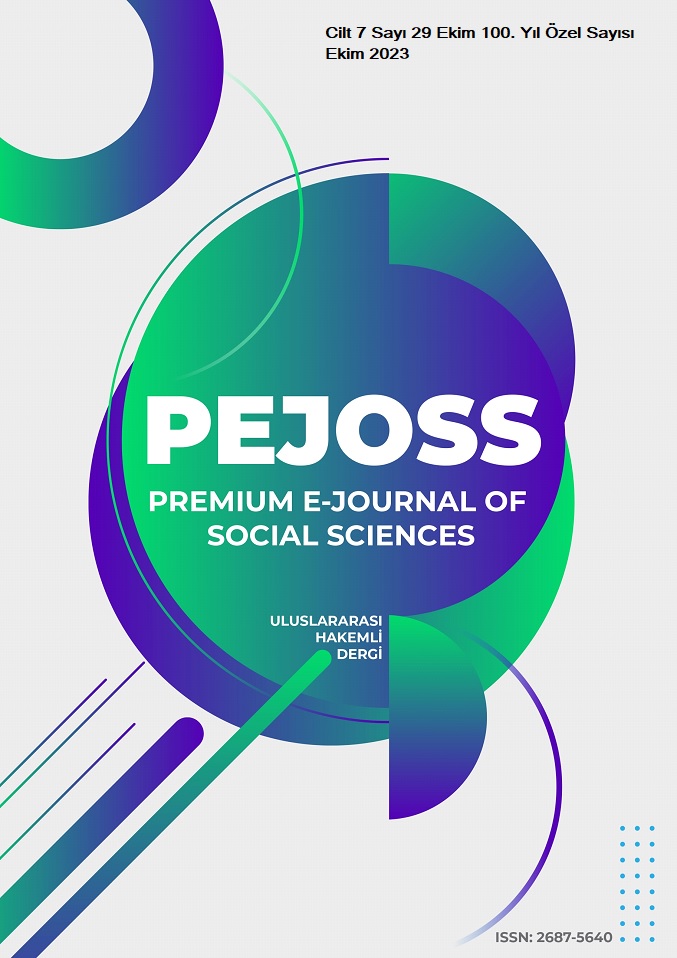3D Design for Food Art: Gastronomy Practice Kitchen
DOI:
https://doi.org/10.5281/zenodo.10052014Keywords:
3D Design, Augmented Reality, Practice Kitchen, GastronomyAbstract
This research focuses on the rapidly growing Gastronomy and Culinary Arts education in Turkey and draws attention to the design of practice kitchens, which is a vital tool to improve the practical skills of students studying in this field. It also focuses on the importance of the 3D design of the gastronomy practice kitchen, covering in detail the definition of the kitchen, its historical development and the functions of the kitchen department.
The gastronomy practice kitchen plays an important role in the development of culinary art. Therefore, planning, organizing and optimizing the functional zones of the kitchen has a direct impact on the quality and presentation of the dishes made by the students.
The article first defines the kitchen and emphasizes that the gastronomy practice kitchen is the center of food preparation processes. Historically, the evolution of cuisine is examined and the evolutionary course of modern gastronomy practice cuisine is explained.
Kitchen planning and parts of the kitchen are examined in detail. The strategic positioning and functionality of the freezer, cold storage, food storage and pastry section play an active role in the food production process that takes place in the kitchen. The design and organization of the dishwashing area ensures that hygiene standards are maintained and sustainable.
As a result, the 3D design of the gastronomy practice kitchen triggers an evolution and development in the art of food. The effective organization of the kitchen's planning and parts improves the quality of the food, providing a high-end experience in the field of gastronomy. This article offers an important perspective on how the art of food can move forward by combining the advantages of 3D design.
Downloads
References
Akman, S. & Erbil, K. (2018). Modern yaşamın sanayi devrimi ile birlikte mutfakta kadına etkileri. The Journal of Academic Social Science, 86(86), 284–292.
Aksu, H. (2018) Antik Çağ’da Mutfak Kültürü. https://cdn.istanbul.edu.tr/FileHandler2.ashx?f=gida-ve-beslenme-kulturu-antik-cag%E2%80%99da-mutfak-kulturu1.pdf
Ayyıldız, S. (2019). Turistik konak işletmelerinde mutfağın fiziksel koşullarının önemi: Safranbolu yöresel mutfak mimarisi üzerine bir araştırma. Karabük Üniversitesi Sosyal Bilimler Enstitüsü Dergisi, 9(2), 610-625.
Battal, S. (2020). Otel mutfaklarında ergonomi ve hijyen uygulamaları etkileşimine yönelik bir araştırma: İstanbul örneği [Yayınlanmamış Yüksek Lisans Tezi], Balıkesir Üniversitesi.
Bayram, F. (2011). Otel mutfaklarında çalışan mutfak çalışanlarının gıda güvenliği konusundaki bilgi tutum ve davranışları [Yayınlanmamış Yüksek Lisans Tezi], Gazi Üniversitesi.
Bayram, F. (2020). Mutfak yöneticilerinin ticari mutfak planlama ilkeleri konusunda bilgi düzeyleri sektörel hatalar ve çözüm önerileri [Yayınlanmamış Doktora Tezi] Hacı Bayram Veli Üniversitesi.
Bucak, T. (2019) Yiyecek içecek işletmeciliği. Detay Yayıncılık.
Bucak, T., & Yiğit, S. (2020). Otel mutfak çalışanlarının mutfak teknolojilerine yaklaşımlarının kelime ilişkilendirme testi ile değerlendirilmesi: İzmir Örneği. Journal of Tourism & Gastronomy Studies, 8(1), 489–500.
Budak, İ. (2015) Otel işletmeleri mutfak planlamasına ilişkin sistematik bir süreç analizi [Yayınlanmamış Yüksek Lisans Tezi] Balıkesir Üniversitesi.
Çam, O. & Çılgınoğlu, H. (2021). Yöresel mutfakların gastronomi turizmindeki önemi: Kastamonu mutfağı örneği. Uluslararası Türk Dünyası Turizm Araştırmaları Dergisi, 6 (1), 176-192.
Doğdubay, M. & Karan, İ. (2017). Otel mutfaklarında sistematik işyeri düzenleme planı (sidp) modelinin uygulanması. Aydın Gastronomy, 1 (1) , 9-23
Doru, S. (2017) Konutlarda mutfakların geçmişten günümüze mimari olarak gelişmesinde teknolojinin etkileri [Yayınlanmamış Yüksek Lisans Tezi]. Haliç Üniversitesi.
Dönmez Karagözler, D. (2022). Konut mutfağının tarihsel gelişimi ve modern mutfak kavramının Doğuşu. Pearson Journal, 7(20), 63–79.
Enes, K. (2021) Mutfakların Fiziksel planlama süreci. Detay Yayıncılık.
Gisslen, W. (2011). Professional Cooking (7th Edition). John Wiley & Sons, Inc.
Kaymaz, E. & Ulema, Ş. (2020) Mutfak sanatı kavramlar, ilkeler ve uygulamalar. Mutfak organizasyonu ve örgüt yapısı. Detay Yayıncılık.
Kırmızıkuşak, D. & Çavuş, O. (2021) Mutfağın tanımı ve tarihsel gelişimi. Nobel Yayınevi.
Kurt, M. (2018) Kapadokya bölgesi otel mutfaklarında çalışanların mutfak hijyen durumları üzerine görüşleri [Yayınlanmamış Yüksek Lisans Tezi]. Gazi Üniversitesi.
Lemme, F.,Neumann, P., Wagner, F. & Schwarz, P. (2013). Professıonal kitchens: plannıng-desıgn- equıpment. Berlin.
Özdemir, G. & Dülger Altıner, D. (2019). Gastronomi kavramları ve gastronomi turizmi üzerine bir inceleme. Erzincan Üniversitesi Sosyal Bilimler Enstitüsü Dergisi, 12(1), 1-14
T.C Çalışma ve Sosyal Güvenlik Bakanlığı (t.y.). Mutfak, Lokanta ve Pastaneler İçin Kontrol Listesi https://www.csgb.gov.tr/medias/3751/mutfaklokanta.docx
Tuzcuoğlu, B. & Bal, H. B. (2023). İç mimarlık ve çevre tasarımı öğrencilerinden mutfak mekânı tasarımında pandemi sürecine ilişkin çözümler. Sanat ve Tasarım Dergisi, (31), 207-237
Türk Dil Kurumu (2020). Mutfak. https://sozluk.gov.tr/
Uyar, P. (2014) Toplu konutlarda mutfak mekânının 1950’lerden günümüze gelişimi [Yayınlanmamış Yüksek Lisans Tezi] İstanbul Teknik Üniversitesi.
Üner, E. H. (2023). Orta çağ’da Avrupa mutfak kültürü. Aydın Gastronomy, 7 (2) , 313-324.
Varol, E. & Seçim, Y. (2022). Gastronomi ve mutfak sanatları uygulama mutfağının tasarım ve tetkiki: İstanbul örneği. Manas Sosyal Araştırmalar Dergisi, 11(2), 764-782.
Downloads
Published
How to Cite
Issue
Section
License
Copyright (c) 2023 Premium e-Journal of Social Science (PEJOSS)

This work is licensed under a Creative Commons Attribution 4.0 International License.


